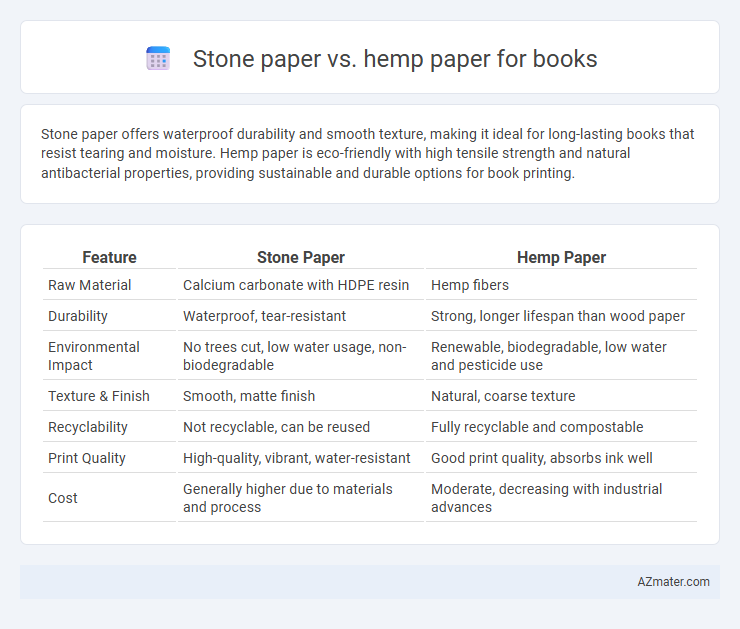Stone paper offers waterproof durability and smooth texture, making it ideal for long-lasting books that resist tearing and moisture. Hemp paper is eco-friendly with high tensile strength and natural antibacterial properties, providing sustainable and durable options for book printing.
Table of Comparison
| Feature | Stone Paper | Hemp Paper |
|---|---|---|
| Raw Material | Calcium carbonate with HDPE resin | Hemp fibers |
| Durability | Waterproof, tear-resistant | Strong, longer lifespan than wood paper |
| Environmental Impact | No trees cut, low water usage, non-biodegradable | Renewable, biodegradable, low water and pesticide use |
| Texture & Finish | Smooth, matte finish | Natural, coarse texture |
| Recyclability | Not recyclable, can be reused | Fully recyclable and compostable |
| Print Quality | High-quality, vibrant, water-resistant | Good print quality, absorbs ink well |
| Cost | Generally higher due to materials and process | Moderate, decreasing with industrial advances |
Introduction: The Rise of Alternative Papers
Stone paper and hemp paper have emerged as sustainable alternatives to traditional wood-based paper in the book industry. Stone paper is made from calcium carbonate bonded with non-toxic resins, offering tear resistance and waterproof qualities. Hemp paper, derived from the fast-growing Cannabis sativa plant, provides high durability, natural texture, and requires fewer chemicals in production, positioning both materials as eco-friendly choices for modern publishing.
What Is Stone Paper?
Stone paper is a synthetic material made primarily from calcium carbonate bonded with high-density polyethylene, offering waterproof, tear-resistant, and eco-friendly properties. Unlike traditional wood pulp paper, stone paper requires no water or bleach in manufacturing, significantly reducing environmental impact and deforestation. Its smooth texture and durability make it an innovative alternative for book printing, especially where longevity and resistance to wear are essential.
What Is Hemp Paper?
Hemp paper is made from the fibers of the hemp plant, known for its durability, sustainability, and biodegradability compared to traditional wood pulp paper. Unlike stone paper, which is produced from calcium carbonate and resin, hemp paper offers a natural, eco-friendly alternative that supports soil health and reduces deforestation. Its high tensile strength and resistance to tearing make hemp paper ideal for book printing, ensuring longevity and reduced environmental impact.
Raw Material Sourcing and Sustainability
Stone paper, made primarily from calcium carbonate derived from limestone, uses less water and trees compared to conventional wood pulp, reducing deforestation and water consumption in raw material sourcing. Hemp paper utilizes fibers from the fast-growing hemp plant, which requires minimal pesticides, absorbs more CO2, and replenishes soil nutrients, making it one of the most sustainable alternatives to wood-based paper. Both materials offer eco-friendly benefits: stone paper boasts a zero-tree-harvest process while hemp paper promotes regenerative agriculture with high fiber yield per acre.
Manufacturing Processes Compared
Stone paper manufacturing involves grinding calcium carbonate into fine powder and binding it with non-toxic resin, creating a smooth, waterproof, and tear-resistant material through an energy-efficient, waterless process. Hemp paper production begins with separating hemp fibers via retting and mechanical processing, followed by pulping and chemical treatments to produce durable, acidic-free sheets with higher tensile strength and sustainability benefits over wood-based paper. The stone paper process is faster with less environmental impact, while hemp paper requires more resource-intensive steps but results in a biodegradable product with superior longevity.
Environmental Impact: Stone Paper vs Hemp Paper
Stone paper produces no trees and relies on crushed stone mixed with non-toxic resin, resulting in zero water consumption and minimal carbon emissions, making it highly eco-friendly. Hemp paper, derived from fast-growing hemp plants, requires less water and fewer pesticides compared to traditional wood pulp, significantly reducing deforestation and pollution. Both options offer sustainable alternatives to wood-based paper, but hemp paper supports soil regeneration while stone paper excels in waste reduction and durability.
Print Quality and Durability
Stone paper offers exceptional print quality with sharp, vibrant images due to its smooth, non-porous surface that resists ink bleed and fading, making it ideal for high-resolution book printing. Hemp paper provides strong durability and a natural, textured feel, enhancing longevity and resistance to tearing, but its fibrous surface may slightly affect print sharpness compared to stone paper. Both materials are eco-friendly alternatives, with stone paper excelling in print clarity and hemp paper standing out for toughness and traditional tactile qualities.
Cost Analysis: Affordability for Book Publishing
Stone paper typically costs 10-30% more than traditional hemp paper due to its unique mineral-based composition and manufacturing process. Hemp paper, derived from fast-growing hemp plants, remains more affordable and sustainable for large-scale book publishing with lower raw material costs and energy consumption. Publishers seeking cost-effective, eco-friendly options often favor hemp paper because it balances price, durability, and environmental benefits better than stone paper.
Recycling and End-of-Life Considerations
Stone paper, made from calcium carbonate and resin, is water-resistant and durable but poses challenges in recycling due to its synthetic resin content, often requiring specialized facilities for proper disposal. Hemp paper, derived from fast-growing hemp fibers, is biodegradable and more easily recycled within conventional paper recycling streams, offering a more sustainable end-of-life option with lower environmental impact. The choice between stone and hemp paper for books significantly affects recyclability, where hemp paper aligns better with circular economy goals and stone paper demands careful handling to minimize landfill waste.
Which Paper is Best for Books?
Stone paper, made from calcium carbonate bonded with resin, offers durability, water resistance, and a smooth writing surface, making it ideal for books requiring long-lasting pages. Hemp paper, derived from the fibers of the hemp plant, is biodegradable, eco-friendly, and boasts strong tensile strength, promoting sustainability while maintaining print clarity. For books prioritizing environmental impact and recyclability, hemp paper is superior, but for durability and moisture resistance, stone paper is the preferred choice.

Infographic: Stone paper vs Hemp paper for Book
 azmater.com
azmater.com